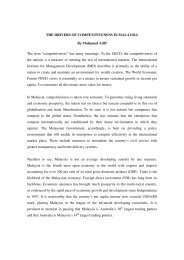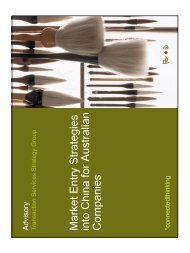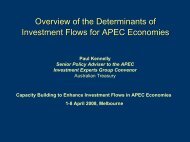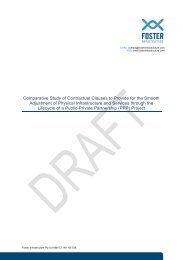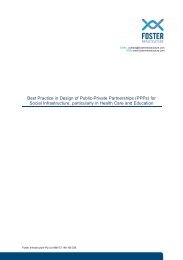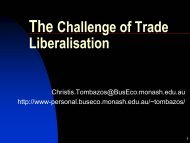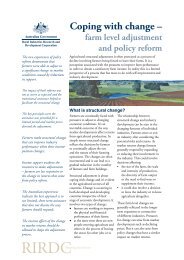Key points
Key points
Key points
You also want an ePaper? Increase the reach of your titles
YUMPU automatically turns print PDFs into web optimized ePapers that Google loves.
Investment-to-GDP ratio of 45% is unsustainable%5045China's fixed investment-GDP ratio%5045Korea's fixed investment-GDP ratioThailand's fixed investment-GDP ratioJapan's fixed investment-GDP ratio (1960-83)404035353030252520201580 82 84 86 88 90 92 94 96 98 00 021580 82 84 86 88 90 92 94 96 98 00 023Investment efficiency is falling7.06.05.04.03.02.01.0ICOR(3yr MA)• Local governments rushing to convertfarmland into industrial zones, whilepromoting property and road projects• Nearly 4,000 industrial parks anddevelopment zones under construction,with a planned area of 36,000 sq km,equal to 1.5 times China’s existing urbanarea, or 62 times the size of Singapore0.081 83 85 87 89 91 93 95 97 99 01 034
Investment in steel, cement and aluminum also too hot...% Yr100806040200-20% Yr100806040200-20-4097 98 99 00 01 02 03Real estateFixed investment in raw materials-405…creating energy and resource bottlenecks% Yr (3mma)2018161412108642088 89 90 91 92 93 94 95 96 97 98 99 00 01 02 03 04Power consumption / production% Yr (3mma)201816141210864206
Quantitative tightening is working%Yr25%Yr2520201515101055098 99 00 01 02 03 04M1 money supply M2 money supply Bank loans07PBoC is sterilizing FX reserve expansion%Yr50454035302520151050hikes in deposit reserve ratio01 02 03 04Base money FX reserves8007006005004003002001000RMBbnPBoC bills outstandingMay-04Mar-04Jan-04Nov-03Sep-03Jul-03May-03Mar-03Jan-038
Interest rate hikes less effective%pa10987654321098 99 00 01 02 03 04Central bank's rediscount rateOne year benchmark lending rate%Yr543210-1-2-398 99 00 01 02 03 04CPI Core-CPI%Yr543210-1-2-39RMB revaluation would boost money inflows4030US$bnFear of RMB devaluationForeign politicalpressure for RMBrevaluation20100-10-20-30Mar-95Sep-95Mar-96Sep-96Mar-97Sep-97Mar-98Sep-98Mar-99Sep-99Mar-00Sep-00Mar-01Sep-01Mar-02Sep-02Mar-03Sep-03Mar-04Changes in FX reserves-trade surplus-FDI inflows10
Credit tightening curbs investment and demand formetal products% Yr200150100500-50Volume of steel product importsVolume of copper imports-10094 95 96 97 98 99 00 01 02 03 04% Yr200150100500-50-100%YrChina's steel production35302520151050-5-10-1587 89 91 93 95 97 99 01 0311China’s sustainable investment growth is 10-12%2002 2008 2003-08 growth forecastUrban population, m 502 600 3.0Annual change,m 15 16 16As % of total population 39 45 n.a.Total residential housing, m sq m 7,036 10,200 6.4Annual growth in property construction 24 12 1212
Hiatus needed to work off excess capacityFixed investment breakdown by sectorOtherservicesectors22%Farming1%Mining3%Manufacturing15%US$bn2502001501002003 total fixed investment=US$664bnThe main area ofexcessinvestmentReal estate31%Power,gasand water17%Transportation11%500FarmingMiningManufacturingPower,gasand waterTransportationReal estateOther servicesectors13The banks may have to bear the burdenPRC banks’ asset qualityNPLs/total loans (%, period end) 20032002 2001 2000Net NPLs/equity (%)2002Bank of China* 18.323.7 27.5 27.2 135Industrial & Commercial Bank 22.525.8 29.8 34.4 420China Construction Bank 9.315.3 19.4 20.3 225Agricultural Bank of China* 36.6 42.1 N/A 500Bank of Communications 18.6 16.5 18.3 157CITIC Industrial Bank* 10.7 15.4 17.4 196China Merchants Bank* 4.9 10.3 13.6 19China Everbright Bank 13.3 20.5 28.8 95Shanghai Pudong3.5 8.6 13.2 12Development BankChina Misheng Banking2.4 4.3 6.0 6CorporationShenzhen DevelopmentBank*8.9 11.7 19.8 163* Five-tier loan classification. Source: Fitch Ratings14
Is the NPL situation beyond redemption?China’s total public debt 2003Treasury bonds outstanding (RMBbn) 1,930Special financial bonds (RMBbn) 1,001Total explicit government debt (RMBbn) 2,931–as% of GDP 28.6Unrecoverable NPLs of state banks (RMBbn) 2,277Pension shortfalls (RMBbn) 5,000Total public debt 10,000–as% of GDP 90Source: PBoC, HSBC15Selling state assets a key financing optionStylized government balance sheet (2003)Liabilities & net worth (RMBbn) Assets (RMBbn)Domestic bonds outstanding 1,930 Market cap. of listed SOEs (A,B, H shares) 4,537Unrecoverable NPLs of state banks 2,277 Net assets of 172,000 unlisted SOEs 3,600Unfounded pension debt 5,000 Other public physical assets 4,618External debt outstanding 1,607 Land and subsoil reserves N/ANet worth >0 Foreign reserve assets 3,345Source: HSBC, Ministry of Finance, PBoC16
Exports and consumption provide a buffer% Yr (3mma)16151413121110987601 02 03 04Value of retail sales (LHS) Value of exports(RHS)% Yr (3mma)45403530252015105017GDP growth to slow from over 12%yoy in 1H04to 7%yoy in 2005/6% Year (annual average) 2000 2001 2002 2003 2004f 2005fNominal GDP (RMBbn) 8,944 9,593 10,239 11,669 13,204 14,538Real GDP 8.1 7.3 8.0 9.1 8.8 7.0Consumer spending 8.5 6.2 6.2 5.1 6.0 6.1Government consumption 13.4 11.5 12.0 8.0 8.0 7.2Fixed investment 9.6 12.2 15.0 26.7 17.0 10.0Merchandise exports 27.9 6.8 22.3 34.7 20.0 15.0Merchandise imports 35.4 8.2 21.2 39.9 29.0 12.0Industrial production (VAI) 11.4 9.9 12.6 17.0 13.4 7.6Retail sales 9.7 10.1 8.8 9.1 8.5 8.3Consumer prices 0.4 0.7 -0.8 1.2 4.0 2.9Current account (% GDP) 1.9 1.5 2.2 1.3 -0.5 0.6Budget balance (% GDP) -2.8 -2.7 -3.0 -2.9 -2.5 -2.3Foreign reserve (US$bn) 165.6 212.2 286.4 403.3 460.0 480.0CNY/USD 8.3 8.3 8.3 8.3 8.3 8.33-month time deposit (%) 2.0 2.0 1.8 1.5 1.6 1.71-yr lending (%) 5.9 5.9 5.3 5.3 5.4 5.818
Investment-related demand to slowDemand generated by every RMB100 of fixed-asset investmentFixed-asset investment 100Machinery and equipment 33.5Non-metal building materials 10.5Metal products 10.0Commercial and catering trade 5.5Coking, gas and petrolum 5.2Transport 4.8Public utilities 3.5Agricultural products 2.2Chemicals 1.9Source: HSBC19Global impact 1: Commodity prices to fallIncrease in Consumption(2002-2003)World copper consumption ('000 tonnes) 637China consumption 1300China % of world consumption 204World steel consumption (m tonnes) 125China consumption 115China % world consumption 92World aluminium consumption ('000 tonnes) 1100China consumption 1850China % world consumption 16820
Global impact 2: Excess capacity to surfacemt3503002502001501005002003 2005 changes (2003-2005)Steel consumptionProduction capacity% Yr (3mma)706050403020100-10-20-3097 98 99 00 01 02 03Real estate investment Auto productionSteel production% Yr (3mma)706050403020100-10-20-3021Global impact 3: The China locomotive loses steamYear 2003 exports to China to China & HK to China to China & HK% of total exports Share of increase in total exportsPhilippines 6.0% 14.5% 101.6% 205.6%Taiwan 14.9% 34.5% 84.5% 66.1%Hong Kong 42.6% -- 64.2% --Korea 18.1% 25.7% 36.2% 50.6%Indonesia 6.2% 8.2% 23.1% 21.6%Thailand 7.1% 12.5% 18.5% 24.0%Singapore 7.0% 17.0% 17.2% 32.8%Malaysia 6.1% 12.0% 10.0% 17.1%Japan 12.2% 18.5% 32.5% 40.7%Japan (Calcuated in JPY term) 12.2% 18.5% 67.9% 79.3%22
Imports from Australia and New Zealand to slow100Australia external trade with China (% Yr, 3mma)100New Zealand external trade with China (% Yr, 3mma)808080806060604020060402004020040200-20-20-20-20-4094 95 96 97 98 99 00 01 02 03 04Imports from China Exports to China-40-4094 95 96 97 98 99 00 01 02 03 04Imports from China Exports to China-4023Appendix 1: Imports from North AsiaExports to China in 2003Rank Korea % of total Singapore % of total Taiwan % of total1 Electronics & electrical equipment 30.7% Electronics & electrical equipment 32.7% Electronics & electrical equipment 34.6%2 Machinery 11.4% Machinery 22.0% Machinery 13.8%3 Optical & instruments 11.0% Mineral products 14.8% Base metals and articles 11.7%4 Base metals and articles 10.8% Plastics & rubber 11.9% Optical & instruments 10.7%5 Chemical products 9.2% Chemical products 9.4% Plastics & rubber 9.9%6 Plastics & rubber 8.7% Optical & instruments 3.1% Textiles 7.1%7 Textiles 6.8% Base metals and articles 2.1% Chemical products 6.7%8 Mineral products 4.6% Wood and paper 0.9% Skins and leather 1.3%9 Motor and transportation 2.3% Motor and transportation 0.8% Wood and paper 1.2%10 Skins and leather 1.4% Agricultural items 0.6% Motor and transportation 0.9%24
Appendix 2: Imports from Southeast Asian countriesExports to China in 2003Rank Thailand % of total Philippines % of total Malaysia % of total1 Machinery 24.3% Electronics & electrical equipment 67.4% Electronics & electrical equipment 51.3%2 Electronics & electrical equipment 22.5% Machinery 21.7% Machinery 12.2%3 Plastics & rubber 19.8% Base metals and articles 3.6% Agricultural items 8.2%4 Mineral products 8.2% Optical & instruments 2.5% Mineral products 6.9%5 Agricultural items 5.5% Agricultural items 2.1% Plastics & rubber 6.6%6 Chemical products 4.4% Mineral products 1.2% Wood and paper 4.8%7 Base metals and articles 4.1% Plastics & rubber 0.5% Chemical products 4.7%8 Wood and paper 4.1% Chemical products 0.4% Base metals and articles 2.4%9 Textiles 2.5% Wood and paper 0.3% Optical & instruments 1.2%10 Optical & instruments 1.9% Textiles 0.2% Textiles 0.7%25Appendix 3: Imports from G-3Exports to China in 2003Rank US % of total Japan % of total EU % of total1 Machinery 17.8% Electronics & electrical equipment 31.4% Machinery 33.3%2 Electronics & electrical equipment 15.9% Machinery 22.6% Electronics & electrical equipment 16.1%3 Chemical products 13.1% Base metals and articles 9.8% Motor and transportation 13.7%4 Agricultural items 11.1% Optical & instruments 8.4% Chemical products 8.9%5 Optical & instruments 8.3% Chemical products 7.3% Base metals and articles 7.3%6 Motor and transportation 8.3% Motor and transportation 5.8% Optical & instruments 5.7%7 Base metals and articles 6.4% Plastics & rubber 5.8% Plastics & rubber 3.9%8 Wood and paper 5.6% Textiles 4.7% Wood and paper 2.7%9 Plastics & rubber 5.5% Stone, cement & glass 1.1% Textiles 1.9%10 Textiles 3.4% Wood and paper 1.1% Agricultural items 1.6%Source: CEIC, HSBC26
Appendix 4: Asian GDP forecastsGDP growth (% Yr) 2001 2002 2003 2004f 2005fChina 7.3 8.0 9.1 8.8 7.0Hong Kong 0.5 2.3 3.3 6.5 3.0India 5.8 4.0 8.1 7.2 6.3Indonesia 3.5 3.7 4.1 4.5 4.2Korea 3.8 7.0 3.1 5.2 4.3Malaysia 0.3 4.1 5.3 6.2 4.7Philippines 3.0 3.1 4.7 4.9 3.5Singapore -1.9 2.2 1.1 7.2 3.6Taiwan -2.2 3.6 3.2 6.5 4.5Thailand 2.1 5.4 6.7 6.2 5.5Source HSBC27Appendix 5: Asian inflation forecastsCPI (% Yr) 2001 2002 2003 2004f 2005fChina 0.7 -0.8 1.2 4.0 2.9Hong Kong -1.6 -3.0 -2.6 0.0 1.5India 4.4 4.0 4.0 3.5 3.5Indonesia 11.5 11.9 6.6 6.2 6.4Korea 4.1 2.8 3.5 3.3 2.9Malaysia 1.5 1.7 1.1 1.3 1.4Philippines 6.1 3.1 3.1 3.7 3.8Singapore 1.0 -0.4 0.5 1.7 1.4Taiwan 0.0 -0.2 -0.3 1.0 1.4Thailand 1.7 0.6 1.8 2.5 2.7Source HSBC28
Appendix 6: Asian interest rate forecasts(Short interest rate, period end) 2001 2002 2003 2004f 2005fChina 2.00 1.70 1.40 1.70 1.70Hong Kong 2.1 1.5 0.2 1.9 3.1India 6.9 5.4 4.5 4.3 4.5Indonesia 17.6 13.1 8.3 8.3 8.5Korea 4.0 4.3 3.8 3.8 3.8Malaysia 3.3 3.2 3.1 3.0 3.5Philippines 10.1 5.6 6.0 8.5 8.5Singapore 1.25 0.70 0.75 1.25 1.75Taiwan 2.6 1.9 1.2 1.8 2.5Thailand 2.9 1.9 1.4 2.3 3.2Source HSBC29Appendix 7: Asian exchange rate forecasts(Vs US$, period end) 2001 2002 2003 2004f 2005fChina (RMB) 8.28 8.28 8.28 8.28 8.28Hong Kong (HKD) 7.8 7.8 7.8 7.8 7.8India (INR) 48.3 48.0 45.5 43.5 43.0Indonesia (IDR) 10,425 8,955 8,465 9,000 9,050Korea (KRW) 1,326 1,200 1,198 1,140 1,140Malaysia (MYR) 3.8 3.8 3.8 3.8 3.8Philippines (PHP) 51.4 53.1 55.5 55.0 55.3Singapore (SGD) 1.85 1.74 1.68 1.67 1.66Taiwan (TWD) 35.0 34.8 34.0 32.5 32.5Thailand (THB) 44.2 43.2 39.6 39.0 39.0Source HSBC30
Appendix 8: Gradual adjustment of currency regime• Increased flexibility in foreign currency holdings– Banks will be able to manage their own forex portfolios– Exporters will be able to retain more forex earnings• Gradual relaxation of outward investment– Companies will be encouraged to make long-term investments in overseas markets– Plans being devised to open global markets to insurance companies and other institutional investors– Local residents will be able to buy foreign currency for overseas education and sightseeing purposes• Renovating the FX market– Beijing will establish a market-maker system as well as new trading products, while more financialinstitutions will be encouraged to participate in the domestic forex market31Appendix 9: Urbanization trend intensifiesUrbanization rate is rising faster%45401.4ppts pa350.5ppts pa300.7ppts pa250.2ppts pa2015105070 74 78 82 86 90 94 98 02Urban population as % of totalA great leap forward in urbanizationUrban population as % of total35% 50% 60%Japan 1935 1952 1960U.S. 1890 1920 1950China 2001 ? ?Sources: Population Census of Japan, US Census Bureau32
Appendix 10: Manufacturing costs comparison (2002)Compensation cost Unit labour costUnited States 21.4 2.1Japan 20.6 2.8Hong Kong 6.3 naTaiwan 6.0 1.6Korea 9.6 2.2Singapore 8.2 naMexico 2.5 1.4Note: China's manufacturing compensation cost was US$0.95/hour in 2002* Unit labour cost = compensation costs per unit of value-added output"Source: Int'l Labour Organisation, Bureau of Labour Statistics, HSBCChina FDI inflows by sources (US$bn)Total HK US Japan Taiwan Korea Singapore1994 33.8 19.7 2.5 2.1 3.4 0.7 1.21995 37.5 20.1 3.1 3.1 3.2 1.0 1.91996 41.7 20.7 3.4 3.7 3.5 1.4 2.21997 45.3 20.6 3.2 4.3 3.3 2.1 2.61998 45.5 18.5 3.9 3.4 2.9 1.8 3.41999 40.3 16.4 4.2 3.0 2.6 1.3 2.62000 40.7 15.5 4.4 2.9 2.3 1.5 2.22001 46.9 16.7 4.4 4.3 3.0 2.2 2.12002 52.7 17.9 5.4 4.2 4.0 2.7 2.32003 53.5 17.7 4.2 5.1 3.4 4.5 2.133Appendix 11: China’s new path of industrialisationThe role of foreign JV in China’s economy in 2003USDbn As % of China's totalFDI inflows 53 8*Foreign joint ventures’ industrial output 135 27.2Foreign jont ventures' exports 240 50Foreign joint ventures’ imports 232 55* As % of China's total fixed investment.Source: HSBC34
DisclaimerThe research analyst(s) who prepared this report certifies(y) that the views expressed herein accurately reflect the research analyst's(s')personal views about the subject security(ies) and issuer(s) and that no part of his/her/their compensation was, is or will be directly orindirectly related to the specific recommendation(s) or views contained in this research report.*in this publication, HSBC Group offices are indicated by the following codes:'AU' HSBC Bank plc - Sydney Branch and HSBC Bank Australia Limited; 'UK' HSBC Bank plc in London in the United Kingdom; 'DE' HSBC Trinkaus & Burkhardt KgaA inDusseldorf, Germany; 'FR' HSBC CCF Social SA in Paris, France; 'HK' The Hongkong and Shanghai Banking Corporation Limited, in Hong Kong SAR in China; 'JP' HSBCSecurities (Japan) Limited in Tokyo, Japan; 'US' HSBC Securities (USA) Inc., in New York, USA.The Treasury and Capital Markets division of The Hongkong and Shanghai Banking Corporation Limited ("HSBC") has issued this research material. This material isdistributed in the United Kingdom by HSBC Bank plc, and in Australia by HSBC Bank plc, Sydney Branch (ARBN 067-3290015) and HSBC Bank Australia Limited (ACN006 434 162). This material is distributed in Japan by HSBC Securities (Japan) Limited. This material may be distributed in the United States solely to "major USinstitutional investors" (as defined in Rule 15a-6 of the US Securities Exchange Act of 1934); such recipients should note that any transactions effected on their behalf willbe undertaken through HSBC Securities (USA) Inc. in the United States. In the UK this material may only be distributed to institutional and professional customers and isnot intended for private customers. It is not to be verified; HSBC makes no guarantee, representation or warranty and accepts no responsibility or liability as to its accuracyor completeness. Expressions of opinion are those of HSBC only and are subject to change without notice. HSBC and its affiliates and/or their officers, directors andemployees may have positions in any distributed or passed on, directly or indirectly, to any other person. Any recommendations contained in it are intended for theprofessional investors to whom it is distributed. This material is not and should not be construed as an offer to sell or the solicitation of an offer to purchase or subscribe forany investment. HSBC has based this document on information obtained from sources it believes to be reliable but which it has not independently securities mentioned inthis document (or in any related investment) and may from time to time add to or dispose of any such securities (or investment). HSBC and its affiliates may act as marketmaker or have assumed an underwriting commitment in the securities of any companies discussed in this document (or in related investments), may sell them to or buythem from customers on a principal basis and may also perform or seek to perform banking or underwriting services for or relating to those companies. This material maynot be reproduced or further distributed in whole or in part for any purpose. No consideration has been given to the particular investment objectives, financial situation orparticular needs of any recipient. (A1DEC2001) (June 2003)The Hongkong and Shanghai Banking Corporation Limited1 Queen’s Road Central, Hong Kong SARTelephone: +852 2843 9111Telex: 75100 CAPEL HXFax: +852 2801 4138Website: www.markets.hsbc.comWebsite: www.research.hsbc.com35




